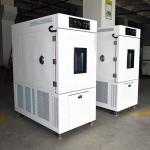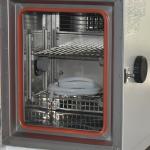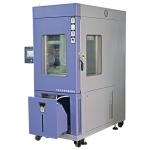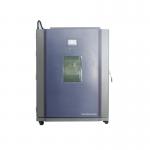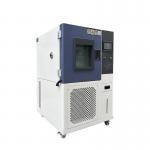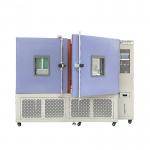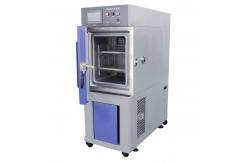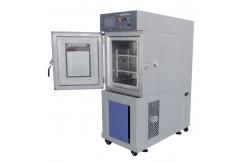In the dynamic world of research, quality control, and product
development, the Programmable Mini Temperature Humidity
Environmental Control Climate Chambers have emerged as a powerful
and versatile solution. These compact yet highly sophisticated
chambers offer precise control over environmental conditions,
enabling a wide range of industries to conduct detailed and
accurate tests. The Programmable Mini Temperature Humidity Environmental Control
Climate Chambers are designed to create and maintain specific
temperature and humidity levels within a confined space. Their
small footprint makes them ideal for laboratories with limited
space or for applications where multiple chambers are required.
These chambers find extensive use in industries such as
electronics, pharmaceuticals, cosmetics, and food. In the
electronics industry, they are used to test the performance and
reliability of small components and devices under various
environmental conditions. For example, a semiconductor manufacturer
can use the chamber to evaluate how temperature and humidity affect
the functionality and lifespan of microchips. In the pharmaceutical
and cosmetic sectors, they help in determining the stability and
shelf life of products, ensuring that they maintain their efficacy
and quality over time. - Compact and Durable Design
- Despite their small size, these chambers are constructed with
high-quality materials to ensure durability and long-term
performance. The exterior is made of sturdy, corrosion-resistant
materials that can withstand the rigors of a laboratory
environment. The interior is designed with a smooth, non-reactive
surface to prevent any interaction between the chamber and the
samples being tested. The insulation used in the chamber walls is
optimized to provide excellent temperature and humidity control
while minimizing energy consumption.
- The door of the chamber is engineered for a tight seal. It is
equipped with a reliable locking mechanism and a gasket that
ensures an airtight closure. The door also features a clear viewing
window, allowing users to monitor the samples without disturbing
the internal environment.
- Precision Temperature and Humidity Control Systems
- The temperature control system is highly accurate, capable of
maintaining a wide temperature range. It can typically be set from
-20°C to +80°C, with an accuracy of ±0.3°C. The system utilizes
advanced heating and cooling technologies, along with a feedback
loop and multiple temperature sensors strategically placed within
the chamber. This ensures uniform temperature distribution and
rapid temperature changes when required. For instance, in a rapid
thermal cycling test, the chamber can quickly transition between
different temperature levels, mimicking real-world conditions such
as a device being turned on and off.
- The humidity control system is equally precise. It can adjust the
relative humidity from 10% to 95% RH, with an accuracy of ±2% RH.
The chamber is equipped with a high-efficiency humidifier and
dehumidifier. The humidifier may use ultrasonic or steam-based
technology, while the dehumidifier can employ condensation or
desiccant methods. This allows for precise control of humidity
levels, which is crucial for testing products that are sensitive to
moisture, such as certain pharmaceuticals and food items.
- Advanced Programmability and Data Acquisition
- These chambers are equipped with a user-friendly programmable
interface. Users can easily set up complex test sequences,
including specific temperature and humidity profiles, dwell times,
and cycling patterns. The programming can be done either directly
on the chamber's control panel or through a connected computer.
This flexibility allows for the replication of a wide variety of
real-world environmental scenarios.
- The data acquisition system is another key feature. It records
temperature and humidity data at regular intervals, providing a
detailed history of the environmental conditions inside the
chamber. The data can be stored in the chamber's internal memory or
exported to a computer for further analysis. This data is
invaluable for understanding how products or samples respond to
different environmental stressors over time. The control panel also
displays real-time temperature and humidity readings, as well as
the status of the control systems and any error messages.
- Volume and Dimensions: The compact size of these chambers typically ranges from a few
liters to around 50 liters, making them suitable for testing small
to medium-sized samples. The interior dimensions are carefully
designed to ensure efficient use of space and optimal distribution
of temperature and humidity.
- Temperature Range: As mentioned, the chamber can operate from -20°C to +80°C. This
range covers many common environmental conditions that products may
encounter. For example, in the food industry, it can simulate
refrigeration and room temperature storage, while in the
electronics industry, it can test components under both cold and
warm operating conditions.
- Humidity Range: The relative humidity can be adjusted from 10% to 95% RH. In the
cosmetic industry, products like creams and lotions may need to be
tested at different humidity levels to ensure their texture and
stability. In the pharmaceutical industry, humidity can affect the
dissolution rate and potency of drugs, and this range allows for
comprehensive testing.
- Uniformity and Stability: The temperature uniformity within the chamber is maintained
within ±0.5°C, ensuring that all samples experience a consistent
thermal environment. The humidity uniformity is within ±3% RH. The
stability of both temperature and humidity is excellent, with
minimal fluctuations over time, allowing for accurate and
repeatable testing.
- Accurate Environmental Simulation
- The primary function of these chambers is to accurately simulate
different temperature and humidity environments. By precisely
controlling these parameters, it allows manufacturers and
researchers to evaluate how products and materials will behave in
various real-world scenarios. For example, in the development of
new packaging materials, the chamber can be used to test how they
protect the contents under different temperature and humidity
conditions, leading to the creation of more effective packaging
solutions.
- The ability to create complex environmental profiles, such as
cyclic temperature and humidity changes, is also a valuable
function. This can help in identifying potential weaknesses or
failure points in products that may not be apparent under static
conditions. For instance, in the automotive industry, small
electronic components in a vehicle can be tested under cyclic
temperature and humidity conditions to simulate the changes they
experience during different seasons and driving conditions.
- Compliance with Industry Standards and Regulations
- Many industries have strict standards and regulations regarding
product testing in specific environmental conditions. The
Programmable Mini Temperature Humidity Environmental Control
Climate Chambers are a reliable tool for ensuring compliance. For
example, in the pharmaceutical industry, products need to meet
certain temperature and humidity requirements to ensure their
safety and efficacy. By using these chambers to conduct tests in
accordance with relevant standards like ICH, USP, or GMP,
manufacturers can prove that their products meet the necessary
criteria, facilitating market access and enhancing consumer
confidence.
- Regulatory bodies rely on accurate test results obtained from such
chambers to enforce safety and quality regulations. It serves as a
dependable means for inspectors and certifying agencies to
determine the suitability of products for use in different
applications.
- Research and Development Support
- In the field of research and development, these chambers are an
invaluable asset. They allow scientists and engineers to conduct
fundamental studies on the effects of temperature and humidity on
new materials and technologies. For example, in the development of
new polymers, the chamber can be used to evaluate how different
temperature and humidity conditions affect their mechanical,
chemical, and physical properties. This data can then be used to
optimize the material formulations and processing techniques.
- The detailed data provided by the test chamber serves as a roadmap
for innovation. It enables researchers to explore new design
concepts and materials that can better withstand environmental
stress, leading to the development of more advanced and reliable
products.
- Stringent Manufacturing Process
- The Programmable Mini Temperature Humidity Environmental Control
Climate Chambers are manufactured under strict quality control
procedures. Each component, from the insulation panels to the
temperature and humidity control systems, is carefully sourced and
inspected for quality and performance. The assembly process is
carried out by highly trained technicians in a clean and controlled
environment, ensuring the proper alignment and functionality of all
parts.
- The calibration of the temperature and humidity sensors and control
systems is a critical and regular part of the manufacturing
process. It is performed using traceable reference standards to
guarantee the accuracy and reproducibility of the test results.
Rigorous quality audits and inspections are conducted at various
stages of production to maintain the highest level of product
quality.
- Quality Certification and Validation
Our chambers have obtained relevant quality certifications and have
been validated by independent testing laboratories. They have been
proven to provide accurate and reliable test results, conforming to
the relevant international and national standards. We also
continuously update and improve our product based on the latest
technological advancements and customer feedback to ensure its
long-term performance and compliance.
|
